





As a founding employee of Gardener's Supply, I wore many different hats over the years. Currently, I have my own company called Johnnie Brook Creative. The gardens around my home in Richmond, VT, include a large vegetable garden, seasonal greenhouse, cutting garden, perennial gardens, rock garden, shade garden, berry plantings, lots of container plants and a meadow garden. There's no place I'd rather be than in the garden.
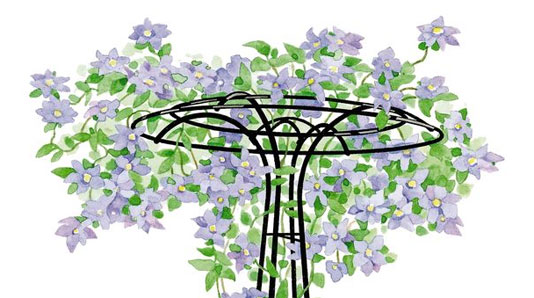
The Essex Trellis has an unusual parasol-shape. Vines grow up and over the top, and then drape gracefully for a stunning display.
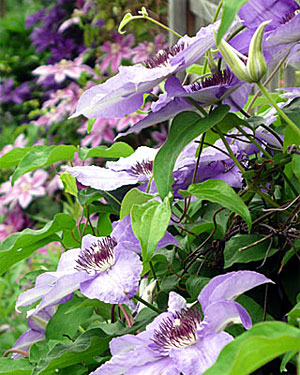
A well-grown clematis in full flower is a sight to behold.
EVERY flower gardener should know the pleasure of growing clematis. If you already have one in your garden, you're probably scheming about how to squeeze in another! New to clematis? Read on and discover how easy it is to be successful with the "queen of climbers."
Until fairly recently, only a handful of clematis cultivars were readily available in the U.S. Some of these traditional favorites include Jackmanii, General Sikorski, Henryi and Comtesse de Bouchard. But clematis have become a hugely popular perennial, and today, the average local garden center offers dozens of different choices.
When selecting a clematis for your garden, you'll want to think about a couple things, which include its mature height, flower form and color.
If you have room for a vigorous 10- or 20-foot clematis vine, there are many wonderful cultivars that will fit the bill. There are also more compact varieties that are perfectly happy growing in a small garden or even in a pot on the patio.
The standard clematis flower form is a large blossom with six or seven petals, measuring 5-6" across. There are also cultivars with smaller blossoms, double blossoms, and lovely bell-like flowers. Colors range from white to wine red, lavender to deep purple, and there are even a few yellow ones.
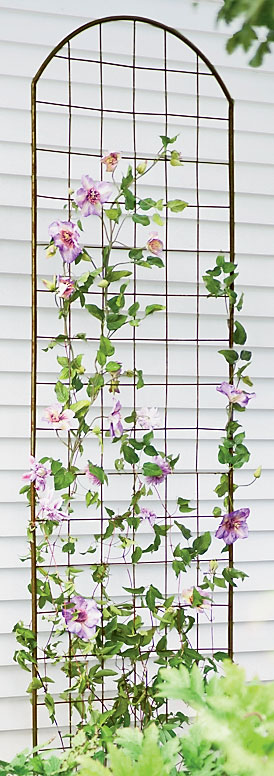
Some trellises are ornate showpieces, not suited to supporting plants. The Jardin Flower Trellis retains the classic lines of Tudor arches, but with a simpler, understated design that makes it easy for clematis to climb.
It can take several years for a clematis vine to mature and begin flowering vigorously. To shorten the wait and help ensure your success, it's best to purchase a plant that's at least two years old. Look for a container-grown plant in a quart or gallon-size pot. If you're shopping for your clematis at a garden center or nursery, select a robust plant that's showing vigorous growth, rather than a weak plant with a beautiful picture.
Hopefully you have a planting location in mind before you bring home your new clematis. Ideally it's a sunny spot. Though some clematis cultivars will bloom in partial shade (such as Nellie Moser and Henryii), to reach their full potential they need at least six hours of sun each day.
Clematis prefer moist, well-drained soil that's neutral to slightly alkaline in pH. If your soil tends to be acidic, you should sweeten it periodically with limestone or a little wood ash. Dig a good hole for your new clematis, working in lots of compost and some granular organic fertilizer.
Be very gentle when settling the plant into its new home; the roots, crown and emerging vines of clematis can be easily broken. Position the plant slightly deeper than it was growing in the pot, so the first set of true leaves is just under the soil surface. Water weekly for the first season, to help the plant get established. If you can get your clematis through its first year, chances are good that it will continue to thrive. Mulching around the base of the plant will help conserve moisture, but keep the mulch several inches away from the crown, where the vines emerge from the soil.
Clematis are happiest with cool shade at their roots and warm sun on their foliage. Mulching around the roots will help keep the soil cool, as will the foliage of a low-growing perennial.
Though there are some types of clematis that have a bushy habit, most of them are born to climb. Like other climbing plants, the growing end of a clematis vine is searching for something to grab onto, and if it can't find anything, it will stop growing. Make sure you provide it with something to climb on from day one.
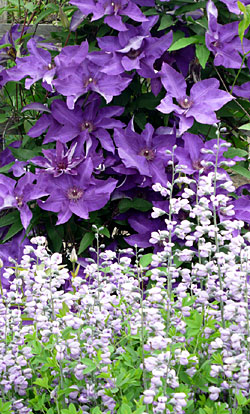
Companion plants, such as this pale-purple baptisia, keep the clematis' root-zone cool.
A clematis vine does not climb by twining around something, as a pole bean or a morning glory does. It climbs by wrapping its leaf stems around something. Because these leaf stems are not very long, anything that's more than about 1/2 inch in diameter is too wide for the leaf stem to twist around. The easiest things for a clematis to grab onto, are twine, fishing line, wire, thin branches, wooden dowels or steel rods. The more grabbing opportunities you offer, the better, so even if you have a nice trellis, consider adding some twine "helper" lines, or covering your trellis with a grid of trellis netting.
Depending on the vigor of the plant and the type of trellis you have, you'll probably need to do some "trussing" during the season to help support the vines and keep them attached to the trellis. Both fishing line and twine work well for this job.
Clematis vary in their need for pruning. Some types flower on last year's vines, so you want to avoid cutting them to the ground in the spring. Others flower on current-year vines, so they don't mind being cut to the ground each year. Rather than driving yourself crazy trying to keep track of the ideal pruning technique for each cultivar, try this common-sense approach: leave the prior year's growth in place until mid-spring. Begin pruning only when you can see which vines are dead and which ones are starting to leaf out.
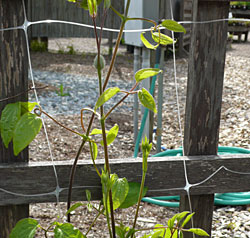
The Nearly Invisible Netting ensures that a clematis can climb the trellis, which has crosspieces that are too wide. Another option is the Biodegradable Netting.
A happy clematis plant puts out an amazing amount of flowers and foliage. Feed your plants well to keep them healthy and vigorous. In early spring, surround the plant with a shovelful of compost and a handful of granular organic fertilizer. Feed again, once or twice during the growing season, with a water-soluble organic fertilizer.
Copyright © www.100flowers.win Botanic Garden All Rights Reserved